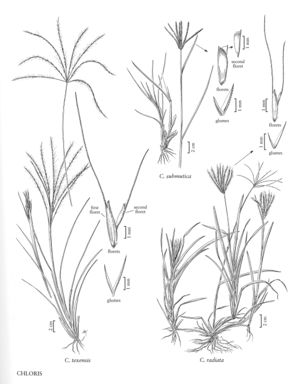Difference between revisions of "Chloris radiata"
imported>Volume Importer |
imported>Volume Importer |
||
| (One intermediate revision by the same user not shown) | |||
| Line 39: | Line 39: | ||
|publication year= | |publication year= | ||
|special status= | |special status= | ||
| − | |source xml=https:// | + | |source xml=https://bitbucket.org/aafc-mbb/fna-data-curation/src/200273ad09963decb8fc72550212de541d86569d/coarse_grained_fna_xml/V25/V25_811.xml |
|subfamily=Poaceae subfam. Chloridoideae | |subfamily=Poaceae subfam. Chloridoideae | ||
|tribe=Poaceae tribe Cynodonteae | |tribe=Poaceae tribe Cynodonteae | ||
Latest revision as of 17:59, 11 May 2021
Plants annual; with dense fibrous root growth, not stoloniferous. Culms 30-60 cm, erect or decumbent, occasionally rooting at the lower nodes. Sheaths usually glabrous, occasionally pilose; ligules membranous, shortly ciliate; blades 10-30 cm long, to 10 mm wide, sometimes with long basal hairs, usually pilose elsewhere, occasionally glabrous or scabrous. Panicles with 5-15, evidently distinct branches in 1-2(3) whorls; branches 4.5-8 cm, spikelet-bearing to the base, with 11-15 spikelets per cm distally. Spikelets with 1 bisexual and 1 sterile floret. Lower glumes 0.7-1.6 mm; upper glumes 2-2.7 mm; lowest lemmas 2.8-3.3 mm long, 0.4-0.6 mm wide, lanceolate to elliptic, sides not conspicuously grooved, mostly glabrous, margins shortly ciliate distally, hairs less than 1 mm, apices awned, awns 6-13 mm; second florets 0.4-0.7 long, about 0.1 mm wide, borne on an equally long or longer rachilla segment, not or inconspicuously bilobed, awned, awns 3-5 mm. Caryopses 1.4-1.5 mm long, 0.3-0.4 mm wide, ellipsoidal. 2n = 40.
Distribution
Puerto Rico, Virgin Islands, Pacific Islands (Hawaii), Fla., Oreg.
Discussion
Chloris radiata is a weedy species of the eastern Caribbean, Central America, and northern South America. It may be native to Florida, but the record from Linton, Oregon, was from a ballast dump. The species is no longer found in Oregon.
Selected References
None.
